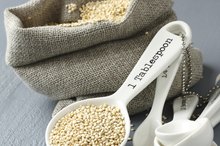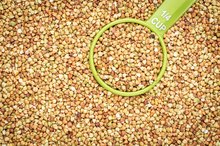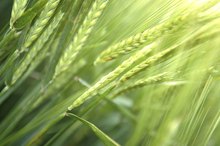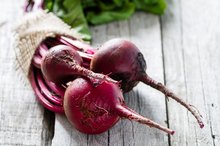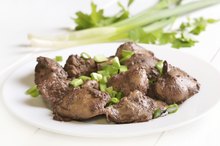Quinoa and Cholesterol
Quinoa, also known as Inca rice, is an ancient grain that has been cultivated and enjoyed by indigenous people in Chile, Brazil, Peru and Ecuador for more than 5,000 years. While quinoa continues to be an important part of the diet of Quechua and Aymara people descended from the Incas, it also enjoys popularity in the U.S. diet because of its nutritional quality and impact on blood cholesterol.
Nutritional Content
Quinoa is one of the only plant foods that's a complete protein. This means that it has all the essential amino acids, which are the building blocks of protein. A 1-cup serving of boiled quinoa packs 8.44 grams of heart-healthy plant protein, more than wheat, rice, rye, corn, barley and many other grains. That same size serving contains only 222 calories and provides 5.2 grams of dietary fiber. Because cholesterol is found only in animal foods, quinoa and other grains are cholesterol-free. Quinoa contains a wide variety of essential minerals and vitamins, as well as a well-balanced assortment of essential amino acids.
- Quinoa is one of the only plant foods that's a complete protein.
- Because cholesterol is found only in animal foods, quinoa and other grains are cholesterol-free.
Cholesterol-Lowering Effects
Is Hummus a Low-Cholesterol Food?
Learn More
When you eat quinoa, the soluble fiber in the grain combines with bile acids from the liver to produce a jelly-like product that’s excreted in your bowel movements. Your liver uses some of its stored cholesterol to create the bile acids. As these stores are depleted, your liver pulls cholesterol from your blood to restock itself. Your total cholesterol level, as well as the amount of LDL, or “bad,” cholesterol in your blood drops. Quinoa is a heart-healthy alternative to meat and other protein sources that are high in saturated fats that can raise your blood cholesterol.
- When you eat quinoa, the soluble fiber in the grain combines with bile acids from the liver to produce a jelly-like product that’s excreted in your bowel movements.
Benefits
Coronary heart disease begins when excess cholesterol and fats from your blood begin to build up on the inner walls of the arteries that bring oxygen-rich blood from your lungs to your heart. The arteries become narrower and more rigid, a condition known as atherosclerosis. When you eat quinoa and other foods that lower your LDL cholesterol, you slow down the rate of atherosclerosis and reduce your risk of developing coronary heart disease, congestive heart failure and heart attacks.
Serving Tips
How to Eat Ground Flaxseed
Learn More
You can boil quinoa just like rice and other grains 3. Enjoy it as a cereal or combine it with other grains to create a pilaf. You can also use it as an extender for wheat flour or cornmeal when baking. To maintain quinoa’s heart-healthy benefits, avoid combining it with cream, butter or other foods high in cholesterol and saturated fat.
- You can boil quinoa just like rice and other grains 3.
- You can also use it as an extender for wheat flour or cornmeal when baking.
Related Articles
References
- Purdue University: Quinoa
- USDA: National Nutrient Database
- Whole Grains Council: Quinoa – March Grain of the Month
- Quinoa, cooked. FoodData Central. U.S. Department of Agriculture. Published April 1, 2019.
- Glycemic Index Food Guide. Diabetes Canada. Updated February 2018.
- Navruz-Varli S, Sanlier N. Nutritional and health benefits of quinoa (Chenopodium quinoa Willd.). J Cereal Sci. 2016;69:371-376. doi:10.1016/j.jcs.2016.05.004
- Giancoli, A. 5 Whole Grains to Keep Your Family Healthy. Academy of Nutrition and Dietetics. Updated August 27, 2018.
- Antioxidants - Protecting Healthy Cells. Academy of Nutrition and Dietetics. Updated March 3, 2020.
- Lim JG, Park HM, Yoon KS. Analysis of saponin composition and comparison of the antioxidant activity of various parts of the quinoa plant (Willd.). Food Sci Nutr. 2020;8(1):694-702. doi:10.1002/fsn3.1358
- Schwingshackl L, Hoffmann G, Lampousi AM, et al. Food groups and risk of type 2 diabetes mellitus: A systematic review and meta-analysis of prospective studies. Eur J Epidemiol. 2017;32(5):363-375. doi:10.1007/s10654-017-0246-y
- Quinoa Allergy. Allergy Knowledge Base. Updated May 16, 2019.
- Kesh S, Barnes CS, Noel-Macdonnell J, Patel NN. Association of quinoa and apple sensitization. J Allergy Clin Immunol. 2018;141(2):AB243. doi:10.1016/j.jaci.2017.12.771
- Types of quinoa. Oldways Whole Grains Council.
Resources
Writer Bio
Sandy Keefe, M.S.N., R.N., has been a freelance writer for over five years. Her articles have appeared in numerous health-related magazines, including "Advance for Nurses" and "Advance for Long-Term Care Management." She has written short stories in anthologies such as "A Cup of Comfort for Parents of Children with Special Needs."



